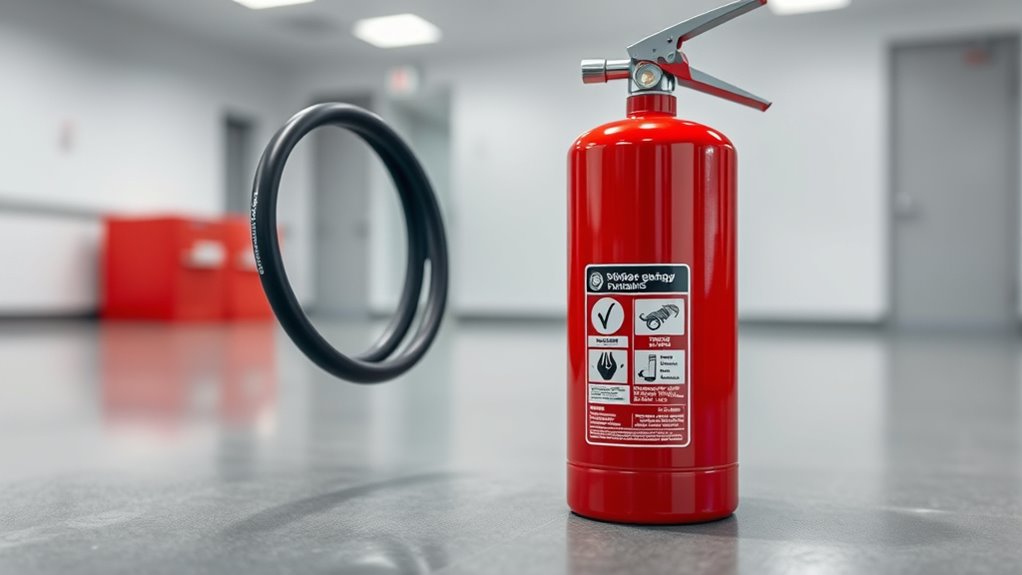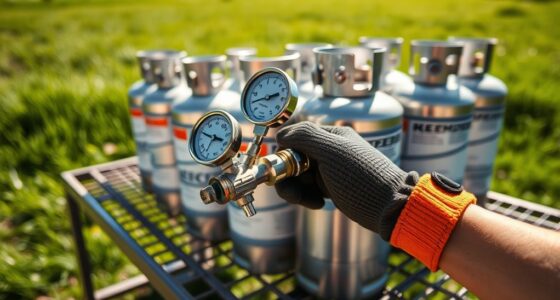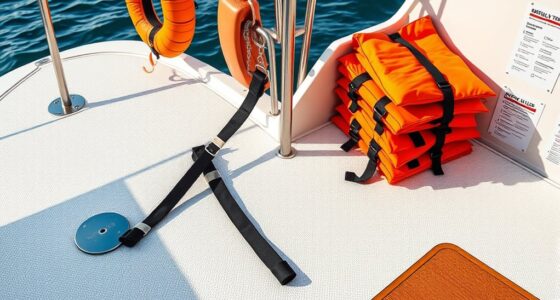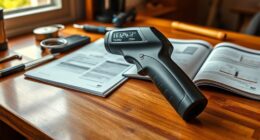To gain confidence with fire extinguishers, start by knowing the different types and their labels, so you can quickly select the right one for any fire. Learn the PASS method—Pull, Aim, Squeeze, Sweep—and always stay safe by checking pressure gauges and keeping safety features intact. Regular practice and maintenance ensure you’re prepared. If you keep exploring, you’ll discover how to stay safe and handle any fire emergency with ease.
Key Takeaways
- Learn to identify fire extinguisher types and labels to choose the correct device for different fire classes.
- Master the PASS technique—Pull, Aim, Squeeze, Sweep—for effective and safe extinguisher use.
- Recognize signs of a fire and ensure proper extinguisher placement for quick access during emergencies.
- Conduct regular maintenance checks on pressure gauges, seals, and nozzles to ensure readiness.
- Develop fire safety plans, keep extinguishers accessible, and practice responses to build confidence and safety awareness.
Understanding the Types of Fire Extinguishers
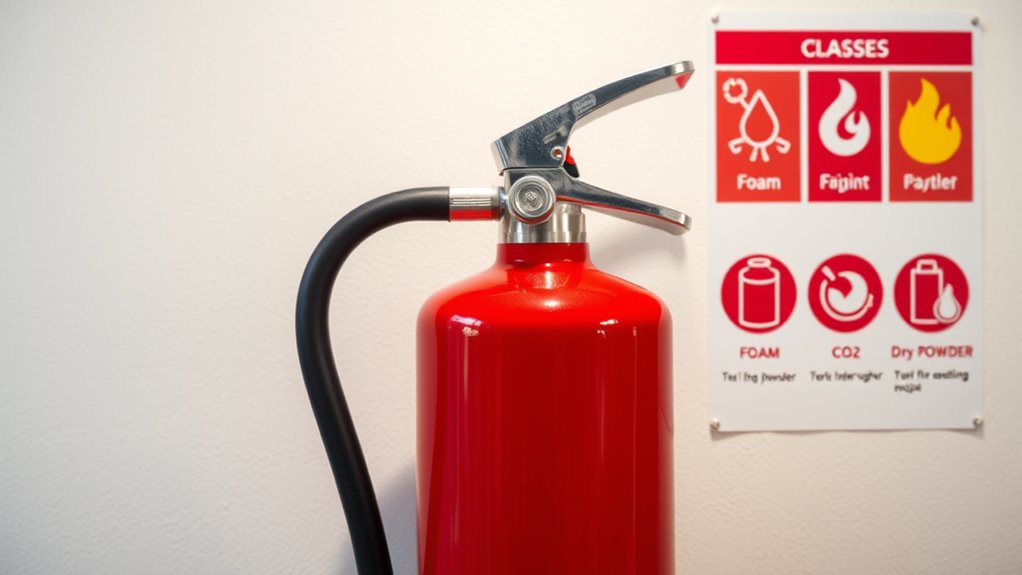
Understanding the different types of fire extinguishers is essential because not all extinguishers work on every kind of fire. Fire extinguisher classifications help you identify which extinguisher to use for specific fires. These classifications are indicated through extinguisher labeling, typically with letters or symbols, showing whether they are suitable for Class A (ordinary combustibles), Class B (flammable liquids), Class C (electrical fires), or combinations like ABC. Recognizing these labels guarantees you choose the right extinguisher quickly during an emergency. Different extinguishers contain various agents, such as water, foam, dry chemical, or CO2, designed for specific fire types. Proper understanding of these classifications helps prevent ineffective use or dangerous situations, giving you confidence to respond effectively when fire strikes. Fire extinguisher labels provide critical information about the appropriate application, ensuring safety and effectiveness in emergencies.
How to Properly Use a Fire Extinguisher
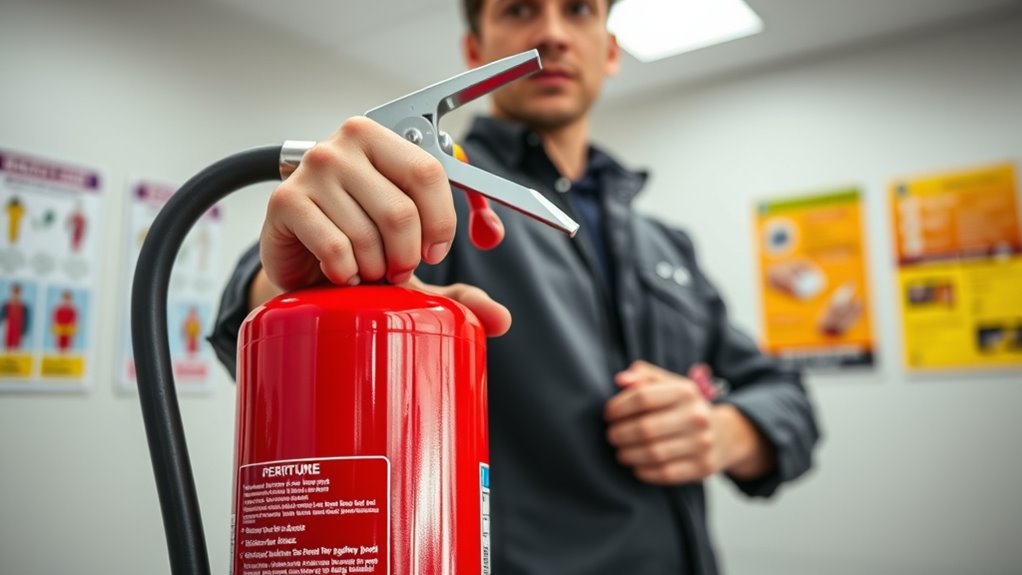
Knowing how to properly use a fire extinguisher can make the difference between quickly controlling a small fire and allowing it to spread. Your fire extinguisher techniques should follow the PASS method: Pull the pin, Aim at the base of the fire, Squeeze the handle, and Sweep side to side. During safety training, you learn to stay calm and keep a safe distance. Always confirm your escape route remains clear before attempting to extinguish a fire. Use the extinguisher on small, manageable fires only, and never turn your back on the flames. Proper training helps you react confidently and effectively. Remember, knowing how to use a fire extinguisher is a critical part of fire safety that can save lives and property. Additionally, understanding the role of a fire extinguisher in different emergency scenarios ensures you are prepared for various types of fires.
Recognizing When to Use a Fire Extinguisher

Recognizing when to use a fire extinguisher is essential for effectively controlling small fires before they escalate. Look for signs such as visible flames, smoke, or heat. Check the fire class identification on the extinguisher to ensure it’s suitable—different classes target different fires. For example, Class A handles common combustibles, while Class B is for flammable liquids. Always keep extinguishers accessible and visible, so you can grab them quickly in emergencies. Use the table below to help identify the right extinguisher based on fire class: fire class identification
| Fire Class | Suitable for | Extinguisher Type |
|---|---|---|
| A | Wood, paper, cloth | Water, foam |
| B | Gasoline, oil | CO2, dry chemical |
| C | Electrical equipment | CO2, dry chemical |
| D | Combustible metals | Special dry powder |
Maintenance and Safety Checks

Regular maintenance and safety checks are essential to guarantee your fire extinguisher functions properly when needed. You should establish routine inspection routines, such as checking pressure gauges to ensure they’re in the operable range and verifying that the safety pin and tamper seal are intact. It’s also important to examine the nozzle for obstructions and confirm the extinguisher’s overall condition. Follow storage guidelines by keeping your extinguisher in an accessible, visible location, away from heat sources or potential damage. Regularly review the expiration date and replace or service units as recommended by the manufacturer. These simple steps help prevent malfunctions during emergencies and ensure your fire extinguisher is always ready to respond effectively.
Tips for Staying Prepared and Safe
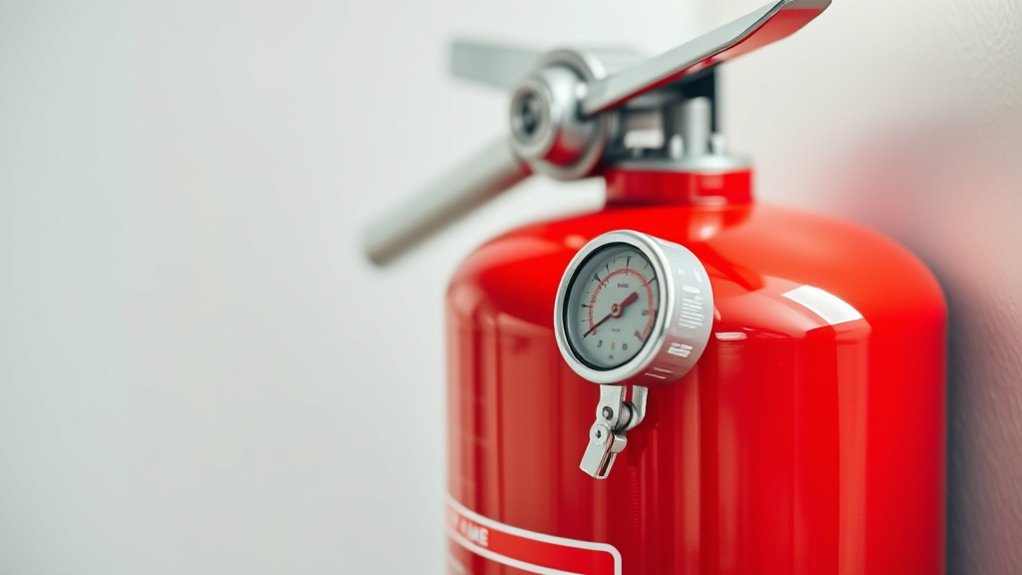
Are you truly prepared to handle a fire emergency? Staying safe means debunking fire safety myths and practicing regular emergency preparedness. Keep a fire extinguisher nearby and ensure everyone knows how to use it. Create a fire escape plan and practice it regularly. Avoid common misconceptions, like thinking a small fire can’t grow quickly or that water always works. Here’s a quick overview to help you stay ready:
| Fire Safety Myths | Emergency Preparedness Tips | Essential Supplies |
|---|---|---|
| Small fires don’t spread | Know your exits and safety routes | Fire extinguisher, first aid kit |
| Water always works | Practice fire drills bi-annually | Flashlights, batteries |
| Smoke alarms are enough | Check alarms monthly | Emergency contact list |
| Fire drills aren’t necessary | Keep emergency plans visible | Fire blankets |
| Only adults should handle fires | Stay calm and act quickly | Safety gloves |
Additionally, understanding the types of fire safety equipment available can help you choose the right tools for different situations.
Frequently Asked Questions
How Often Should Fire Extinguishers Be Replaced?
You should replace fire extinguishers when their maintenance schedules or inspection procedures indicate they are no longer reliable. Typically, they need replacing every 5 to 15 years, depending on the type and manufacturer’s recommendations. Regular inspections, usually annually, help identify if the pressure gauge is in the operable range or if the extinguisher has damage or corrosion. Always follow your local safety guidelines for proper replacement intervals.
Can Fire Extinguishers Be Refilled or Reused After Use?
Sure, fire extinguishers can be refilled and reused, but only if you follow proper refill procedures and reuse guidelines. After use, don’t just shake it off—have it inspected and refilled by a professional. Think of it like giving your trusty sidekick a quick upgrade. Ignoring these steps might turn your hero into a hollow shell, useless when fire strikes again. So, always trust trained technicians to handle the refill process.
Are There Any Common Mistakes to Avoid When Using a Fire Extinguisher?
You should avoid misusing extinguishers and neglecting safety procedures when using a fire extinguisher. Always aim at the base of the fire, use a steady sweeping motion, and keep your back to an exit. Don’t spray too long or hesitate, as this can waste the extinguisher or cause injury. Remember, misusing extinguishers or ignoring safety steps can make the situation worse, so stay alert and follow proper techniques.
What Should I Do if a Fire Extinguisher Is Expired or Damaged?
If you find your fire extinguisher expired or damaged, don’t just shrug and hope for the best. Instead, follow proper inspection procedures and guarantee correct storage safety. You should replace or have it inspected by a professional, because using compromised equipment is like trusting a broken umbrella in a hurricane. Keep safety first—regular checks save lives. Remember, an expired or damaged extinguisher isn’t just useless; it’s a hazard waiting to happen.
Are Fire Extinguishers Effective Against All Types of Fires?
Fire extinguishers aren’t effective against all fire types due to their classifications and fire type limitations. You must select the right extinguisher for specific fires, like Class A for ordinary combustibles, Class B for flammable liquids, or Class C for electrical fires. Using the wrong type can be ineffective or even dangerous. Always check the extinguisher’s label to make sure it’s suitable for the fire you’re facing.
Conclusion
Remember, being prepared is key—fire safety isn’t just about knowing the basics, but acting confidently when it counts. Regular maintenance and recognizing fire risks keep you one step ahead. Think of it like a fire extinguisher’s job: quick action can make all the difference between chaos and control. Stay vigilant, keep your skills sharp, and never underestimate the power of being proactive—because an ounce of prevention is worth a pound of cure.
